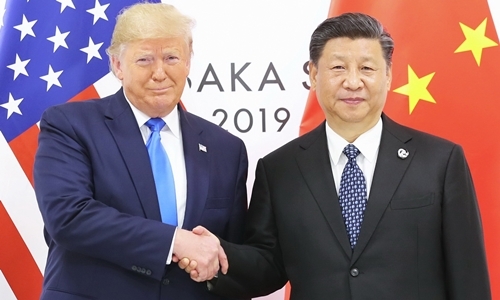"Trade ceasefire" last week's trade war helped Trump - Xi win at a time of pressure.
For months, Trump has pressured Beijing by imposing heavy taxes in the hope of reaching a comprehensive trade deal, addressing a series of U.S. concerns about how China manages the economy. Meanwhile, high-level Chinese officials responded to Trump's imposition of tariffs and emphasized that any deal must have a prerequisite that the US completely abolish the tariffs.

US President Trump (left) and Chinese President Xi Jinping on Photo: AFP
However, on 11 October, the two sides decided that a better part of the deal did not exist. They agreed on a preliminary agreement that China would buy more US agricultural products and take some steps to open up the economy, in exchange for US jobs to give up plans to raise taxes next week. The move will help ease a trade war that has caused significant damage to the world's two largest economies.
Xi Jinping is facing violent street protests in Hong Kong as well as sharply rising domestic commodity prices. And Trump desperately wants a story to divert public opinion from a impeachment investigation and a series of doubts about the communication between his team and Ukraine. Both leaders face daily negative economic news because the trade war is weighing on production and business investment.
"It is clear that the Sino-US trade war is at a standstill," said Edward Alden, an expert at the Council on Foreign Relations. "At this point, neither side sees any escalation in the benefits. The president wants a positive event to benefit the 2020 campaign and the Chinese want the same thing because economic reasons ".
Trump and his advisers dismissed the trade war as causing economic damage in the United States. However, the evidence is increasingly difficult to ignore. Earlier this week, the International Monetary Fund warned that a U.S.-China trade war could cost the global economy about $ 700 billion by 2020 - equivalent to the size of the entire Swiss economy. .
As Trump's re-election campaign drew near, he and his advisers became increasingly aware of the need to limit any economic damage, especially to key voters like farmers, those who who must suffer the most in battle.
The US agricultural economy was in recession due to a sharp decline in sales to China of key products such as soybeans, pork and corn. While the government has been trying to reduce the damage with two rounds of financial support, farmers are increasingly expecting the White House to end the trade war, saying the subsidy is not enough to make up for lost sales.
That pain is in danger of getting worse this week. Before the "ceasefire" deal on 11/10, Trump planned to raise taxes from 25% to 30% on $ 250 billion of goods. If that happens, China is more likely to retaliate, resulting in American consumers and businesses about to enter the holiday season to suffer.
As for Mr. Xi, rising food prices have become a big problem in China. African pig cholera has led to a sharp rise in the price of pork as well as substitutes such as beef and lamb. When the Chinese public began to ask "where is the beef", the trade negotiators had the answer: It could come from America, along with lots of pork, soy and other food.
But while the deal benefits certain industries, it is less likely to reverse divisions between the world's two largest economies. With the new agreement, the US retains tariffs imposed for the past 16 months on a range of Chinese industries. That could lead to companies still trying to shift production away from China, perhaps to the United States, but more likely to be US allies in Southeast Asia.
Eswar Prasad, a trade policy professor at Cornell University, said the deal helped no new sanctions have been introduced but failed to address the fundamental rift between the two countries. "It is hard to argue that this move is a step down the real stress ladder," Prasad said.
Trump on October 11 said China agreed to buy US $ 40-50 billion of American farm produce annually, while the pre-trade level was around US $ 24 billion. There is no guarantee that China will continue to agree to concessions when it is in a time of political sensitivity. The next three weeks, the 204-member Central Committee of the Chinese Communist Party will take place. This is the first meeting since February last year.
Xi is responsible for the state of the US-China relationship as well as the state of the Chinese economy. To handle trade negotiations with the United States, Xi chose a Communist Party committee that he personally oversees and leaves one of his closest advisers, Deputy Prime Minister Liu He, in charge.
"In the current dilemma, he needs to have answers for Central Committee members attending the meeting," wrote former editor Deng Yuwen of a party magazine in Beijing.
There is still a risk that the US-China agreement will collapse after the Central Committee of the Party meets. Beijing seems to be hedging that risk. Chinese state-run media did not describe what the two sides agreed to was a realistic agreement. Mr. Trump himself also said that the legal details of the agreement have not been finalized and have not been presented in writing.
China and the US have reached two "ceasefire" agreements, the first in December in Buenos Aires and the second in June in Osaka. The Buenos Aires deal lasted 5 months while the Osaka deal collapsed in a month.
"Anything is possible," Trump answered when asked if the deal could collapse before the two sides signed it at the Asia-Pacific Economic Cooperation (APEC) forum in Chile next month. or not. "That might happen. But I don't think things will go that way. I think we know each other very well."



 RonaldMiranda
RonaldMiranda







